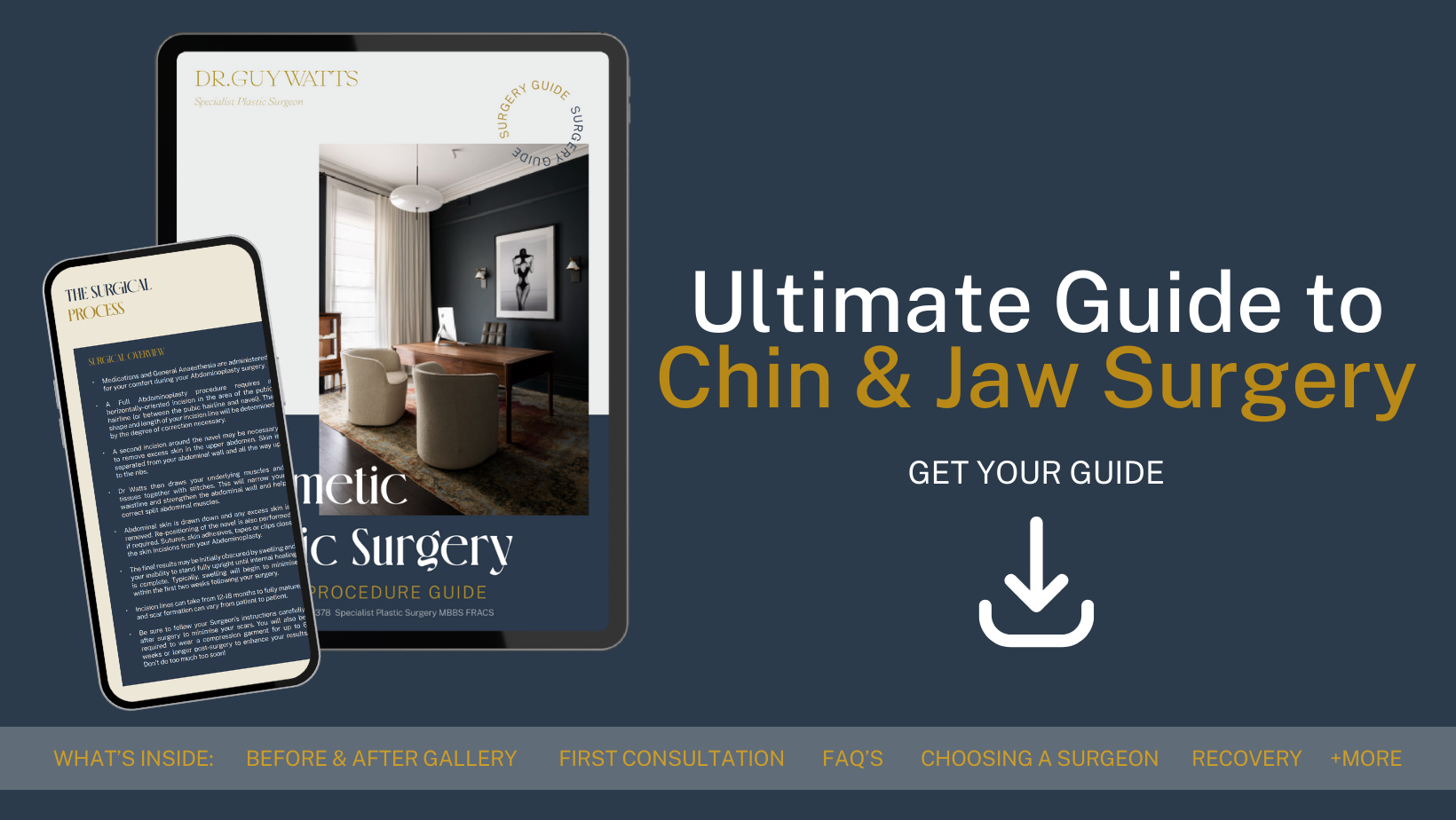
18 May Recovery after Neck Lift
How Is the Recovery after Neck Lift Surgery
If you are interested in undergoing Neck Lift surgery, you should know that the procedure’s success lies not only in the hands of the plastic surgeon but also in the crucial phase that follows, recovery. In this blog we will discuss how to prepare for recovery after Neck Lift surgery and what to expect during this phase.
Perth Specialist Plastic Surgeon Dr. Guy Watts has a deep appreciation and understanding of how facial structure, ageing, and aesthetic appearance are intricately connected. With his extensive training, he will tailor an approach specifically for you, taking your goals into consideration.
Take our quiz, and find out if you are ready for surgery
Preparing for Your Recovery after Neck Lift Surgery
Preparing for your Neck Lift journey involves a series of essential steps that set the stage for optimal results. Mastering the pre-operative stage is crucial. This means effectively communicating with Dr. Watts, discussing your goals, and understanding the procedure in detail.
Another important aspect is having a realistic recovery timeline. It’s okay to be eager to see the final results, but it’s equally important to be patient and realistic. By setting reasonable expectations, you can approach your recovery with a sense of calm and understanding, allowing your body to heal and reveal the full extent of your procedure.
Last but not least, assembling your support team is vital. Reach out to trusted family members, friends, or caregivers who can offer their assistance and support during your recovery. Whether it’s help with daily tasks, lending an ear, or simply being there for you, your support team should be by your side, making your journey more manageable.
Immediate Post-Surgery Care
The immediate post-surgery care phase is a critical time for recovery after a Neck Lift. By prioritising immediate post-surgery care, you set the foundation for your healing process, allowing you to progress toward your desired results.
- Nurturing support from caregivers: During the immediate post-surgery period after a Neck Lift, the role of caregivers becomes paramount in providing the comfort that aids in your recovery. Caregivers offer valuable assistance and emotional support, making sure your body and mind are looked after during this critical phase. From helping you manage pain and discomfort to assisting with daily activities, their presence brings a sense of reassurance and relief.
- Pain management techniques: In the immediate aftermath of a Neck Lift surgery, alleviating the pain becomes a primary concern for a comfortable and successful recovery. Applying ice packs to the surgical site can help reduce swelling and numb the area, providing relief. Keeping your head elevated while resting can also alleviate pressure and reduce discomfort. Communicating openly with Dr. Watts and medical team about your pain levels will enable them to adjust the pain management plan accordingly.
- Nurturing your incisions with care: After Neck Lift surgery, looking after your incisions is essential for optimal healing and reducing the risk of complications. Dr. Watts will provide specific instructions for incision care, which may include cleaning the incisions with mild soap and water, applying prescribed ointments or dressings, and keeping the area clean and dry. It’s important to handle the incisions carefully, avoiding excessive touching or rubbing. Protecting the incisions from direct sunlight and avoiding activities that may strain the neck area is crucial during this phase.
What Happens During Recovery after a Neck Lift Surgery
The recovery period begins as soon as the Neck Lift surgery concludes, and understanding the healing process is key to effectively managing the side effects that could occur after the intervention. Swelling and bruising are to be expected after a Neck Lift and are the bodies response to trauma as it heals.
Swelling reaches its peak within the first few days post-surgery and gradually subsides over the following weeks. Bruising may also occur, but its duration and intensity can vary from person to person.
To reduce swelling, Dr. Watts may recommend the use of cold compresses or ice packs in the immediate post-operative period. This can help constrict blood vessels and reduce inflammation.
To address bruising, Dr. Watts may advise arnica or bromelain supplements, which are known for their potential to reduce bruising and inflammation. These remedies can be taken orally as directed, in conjunction with any prescribed medications, to help the healing process.
Keeping your head elevated while resting and sleeping can also aid in reducing swelling. Using an extra pillow or sleeping in a reclined position can help facilitate proper lymphatic drainage and reduce fluid accumulation.
It’s crucial to remain patient during the healing process, as swelling and bruising will gradually fade over time. You should avoid activities that can increase swelling or hinder the healing process, such as intense physical exertion or excessive sun exposure.
DOWNLOAD DR WATTS’ GUIDE TO JAW AND CHIN SURGERY

Rest During Recovery after Neck Lift Surgery
During sleep, our bodies undergo repair and replenish cells and promote overall healing. After a Neck Lift, prioritising ample rest becomes crucial for optimal recovery. It is essential to find the right sleep position and support, making sure your neck and head are properly aligned and comfortable. Good sleep allows your body to heal more efficiently, reduces swelling, and supporting the body’s regenerative processes.
Good sleep not only aids in the body’s healing process but also promotes overall well-being. To optimise your sleep experience, consider implementing these tips:
- A sleep-friendly environment: Make your sleep space comfortable and conducive to relaxation. Make sure your bedroom is cool, dark, and quiet. Invest in a supportive pillow and mattress that properly align your neck and spine.
- Limit exposure to electronic devices: The blue light emitted by electronic devices can interfere with your sleep. Avoid using screens, such as smartphones or tablets, for at least an hour before bed.
- Avoid stimulating substances: Limit the consumption of caffeine, nicotine, and alcohol, as they can disrupt sleep patterns and prevent deep sleep.
What Diet Is Recommended During Recovery
A well-balanced diet rich in vitamins, minerals, and antioxidants is essential for optimal recovery after any type of surgery. You should include lean meat and plenty of fruit and vegetables in your diet during the recovery period.
Furthermore, specific nutrients can be particularly beneficial during the recovery phase. Vitamin C supports collagen production, which contributes to skin health and wound healing. Foods like citrus fruits, berries, and leafy greens are excellent sources of vitamin C. Omega-3 fatty acids, found in fatty fish, nuts, and seeds, possess anti-inflammatory properties that can help reduce swelling and promote healing.
Proper hydration is equally important. Drinking an adequate amount of water throughout the day supports cellular function, aids in flushing out toxins, and maintains optimal skin hydration. Aim to drink at least eight glasses of water daily, and adjust your intake based on activity level and climate.
Resuming Day to Day Activities and Exercise after a Neck Lift Surgery
Tailored exercise guidelines play a vital role in recovery after a Neck Lift. These guidelines are designed to make sure you have an effective transition back into physical activity. You will receive specific instructions based on your unique needs, taking into account the extent of the procedure and your body’s healing progress. The guidelines may involve a gradual approach, starting with light movements, stretching exercises, and low-impact activities. As your recovery progresses, Dr. Watts may gradually suggest more challenging exercises to rebuild strength and flexibility.
Scars after Neck Lift
Scars are part of the healing process and signify the body’s remarkable ability to repair itself. During a Neck Lift, incisions are strategically placed to reduce visibility.
Initially, scars may appear red, raised, or slightly swollen. Over time, scars gradually undergo change, fading and flattening as the healing progresses. The timeline for scar maturation varies from person to person, and it’s important to be patient as your body works to remodel the scar tissue.
While you cannot completely erase scars, there are various scar management techniques that can help reduce their appearance. Specific treatments such as silicone gel or sheets, which have been shown to effectively soften and flatten scars, might be recommended. Additionally, keeping the incision site protected from sun exposure and using sunscreen can prevent hyperpigmentation and reduce discolouration.
FAQs about Neck Lift Recovery
How long does the Neck Lift recovery take?
- The duration of recovery can vary depending on individual factors and the extent of the procedure.
- Generally, it takes about 2-4 weeks for initial healing stage, during which swelling and bruising gradually subside. However, it can take months before you see the final results of your surgical intervention.
When can I get behind the wheel after the procedure?
- The ability to drive after a Neck Lift varies from person to person and depends on factors such as the extent of the surgery and your overall comfort level.
- It is usually recommended to refrain from driving for at least the first week post-surgery or until you can move your neck comfortably and have discontinued any pain medications that may impair your driving abilities.
- Always consult with Dr. Watts for specific guidance tailored to your situation.
When can I resume daily activities?
- The timeline for resuming daily activities after a Neck Lift depends on the individual’s healing progress.
- While light activities can usually be resumed within a week or two, more strenuous activities and exercise should be avoided for at least 6 weeks to allow the body to heal.
- It’s important to follow Dr Watts’ instructions and gradually reintroduce activities to avoid complications.
What are the hidden challenges and risks during the recovery process?
- Neck Lift surgery like any invasive procedure carries potential risks and challenges, these can include; temporary numbness or altered sensation, swelling, bruising, pain or discomfort, infection, scarring issues, and potential complications specific to anaesthesia.
- It’s crucial to closely follow Dr. Watts’ post-operative instructions, attend follow-up appointments, and promptly report any concerns or unexpected symptoms to optimise recovery and address any challenges or risks promptly.
Further Reading about Face Procedures with Dr. Guy Watts
- Read Dr. Watts’ Face Lift / Neck Lift Surgery Page
- Read Dr. Watts’ Non-Surgical Facial Refresh
- Read Dr. Watts’ Facial Augmentation
- See Dr. Watts’ Facelift Before and After Gallery Page
- Read Dr. Watts’ Blepharoplasty Surgery Page
- Read Dr. Watts’ Heavy Neck – Causes and Options
Medical References about Recovery After Neck Lift Surgery
- Neck Lift (Platysmaplasty): Surgery, Recovery & What to Do – Cleveland Clinic
- Neck Lift Recovery: What to Expect – American Society of Plastic Surgeons
- Neck lift surgery: What to expect, recovery time and risks – Medical News Today
About Dr. Guy Watts – MED0001539378
FRACS (Plas) – Specialist Plastic Surgeon In Perth WA
Dr. Guy Watts is a Specialist Plastic Surgeon (AHPRA MED0001539378) with an extensive career that spans across renowned plastic surgery clinics worldwide. His experience has been honed through invaluable experiences at esteemed establishments such as the New York Eye and Ear Infirmary and the renowned Pitanguy Clinic in Brazil.
Having collaborated with the foremost cosmetic plastic surgeons on a global scale, Dr. Watts has chosen to return to Perth after a 17-year journey of intensive training and invaluable professional experience to bring the latest practices and technology in cosmetic plastic surgery to his patients.
Dr. Watts is a Fellow of the Royal Australasian College of Surgeons (FRACS) and a Member of the Australian Society of Plastic Surgeons (ASPS), Australasian Society of Aesthetic Plastic Surgeons (ASAPS) and the International Society of Aesthetic Plastic Surgeons (ISAPS).
Read about the potential Risks and Complications of Surgery
Read the Patient Information and Resources
About CLINISPA
Clinispa is Dr Watts’ bespoke medical clinic performing Cosmetic Aesthetic treatments. At Clinispa, we offer advanced clinical treatments in a luxurious and calming environment, tailored to support your skin’s health and appearance.
Clinispa aesthetic services are performed by Dr Guy Watts’ nursing professionals, who have a passion for and solid understanding of facial aesthetics.
All Clinispa clients are considered individually, with a personalised treatment plan consisting of advanced scientific approaches to cosmetic aesthetics. We incorporate innovative technologies in conjunction with superiorly formulated skin care.
For more information about the full range of Clinispa Aesthetic of Cosmetic Treatments visit the Clinispa website








Sorry, the comment form is closed at this time.